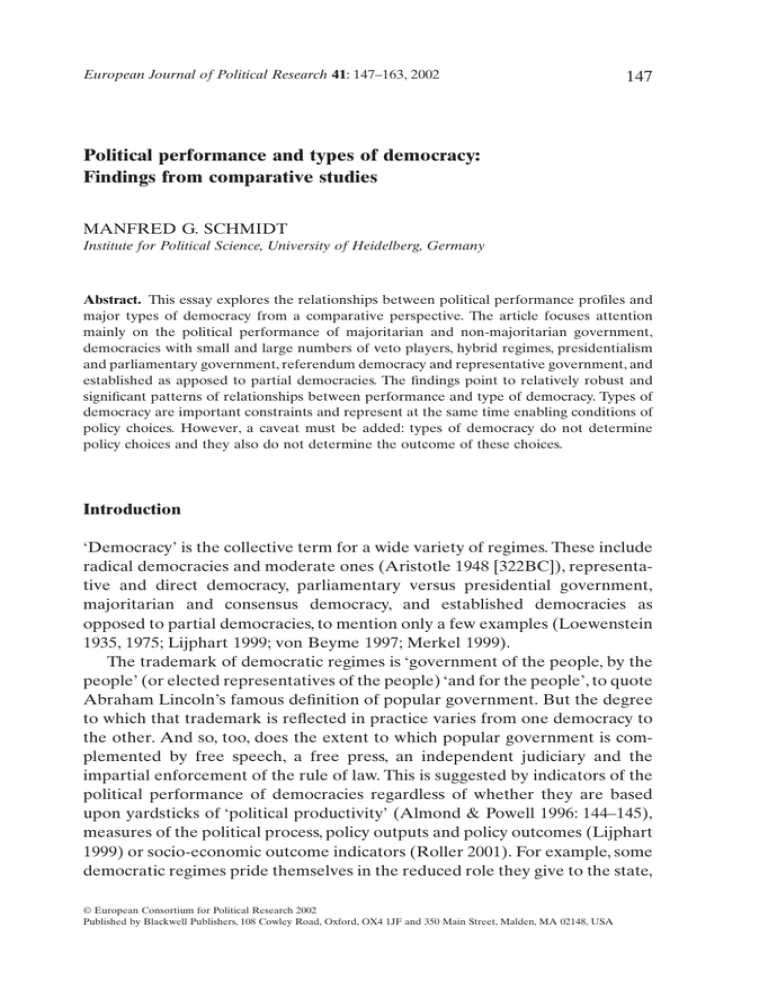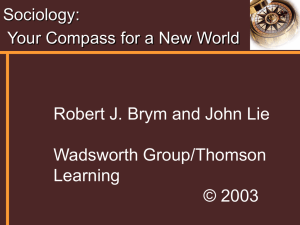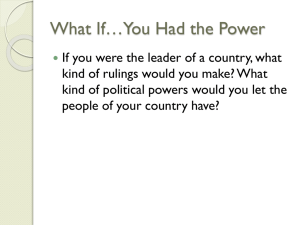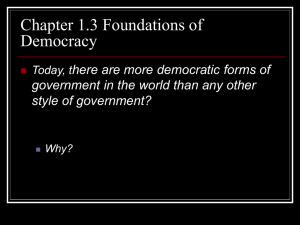Political performance and types of democracy: Findings from
advertisement

European Journal of Political Research 41: 147–163, 2002 147 Political performance and types of democracy: Findings from comparative studies MANFRED G. SCHMIDT Institute for Political Science, University of Heidelberg, Germany Abstract. This essay explores the relationships between political performance profiles and major types of democracy from a comparative perspective. The article focuses attention mainly on the political performance of majoritarian and non-majoritarian government, democracies with small and large numbers of veto players, hybrid regimes, presidentialism and parliamentary government, referendum democracy and representative government, and established as apposed to partial democracies. The findings point to relatively robust and significant patterns of relationships between performance and type of democracy. Types of democracy are important constraints and represent at the same time enabling conditions of policy choices. However, a caveat must be added: types of democracy do not determine policy choices and they also do not determine the outcome of these choices. Introduction ‘Democracy’ is the collective term for a wide variety of regimes. These include radical democracies and moderate ones (Aristotle 1948 [322BC]), representative and direct democracy, parliamentary versus presidential government, majoritarian and consensus democracy, and established democracies as opposed to partial democracies, to mention only a few examples (Loewenstein 1935, 1975; Lijphart 1999; von Beyme 1997; Merkel 1999). The trademark of democratic regimes is ‘government of the people, by the people’ (or elected representatives of the people) ‘and for the people’, to quote Abraham Lincoln’s famous definition of popular government. But the degree to which that trademark is reflected in practice varies from one democracy to the other. And so, too, does the extent to which popular government is complemented by free speech, a free press, an independent judiciary and the impartial enforcement of the rule of law. This is suggested by indicators of the political performance of democracies regardless of whether they are based upon yardsticks of ‘political productivity’ (Almond & Powell 1996: 144–145), measures of the political process, policy outputs and policy outcomes (Lijphart 1999) or socio-economic outcome indicators (Roller 2001). For example, some democratic regimes pride themselves in the reduced role they give to the state, © European Consortium for Political Research 2002 Published by Blackwell Publishers, 108 Cowley Road, Oxford, OX4 1JF and 350 Main Street, Malden, MA 02148, USA 148 manfred g. schmidt the larger role for the private sector and the higher degree of economic freedom they reserve for the individual, such as most English-speaking nationstates. In contrast to this, other democracies produce big government and collective care from cradle to grave, such as the constitutional democracies in Northern Europe, Benelux, France and Germany. It is uncontroversial to argue that performance levels vary from one democratic country to the other. More controversial is the nature of the relationship between levels of political performance and types of democracy (Lijphart 1999; Armingeon in 2002a [in press], 2002b [in press]). However, comparative studies on democracies conducted over the last two or three decades have shed more light on the relationship between performance profiles and types of democracy. Particularly helpful have been investigations of the strengths and weaknesses of different types of democracies (see, e.g., Lipset 1995; Keman 1997, 2001; Schmidt 1999, 2000: 307–388, 489–538; Roller 2001). It is chiefly on these contributions, that this essay is based. Simple rules do not fit, but the difference between majoritarian and non-majoritarian democracy clearly matters One result of comparative studies of the behaviour, output and outcome of democracies has been that simple generalizations do not fit. An example is the widespread belief that majoritarian democracies of the US or British brand are superior to all other forms of democracy. Majoritarian democracies were long regarded as more stable, fitter for survival even under adverse circumstances such as during the interwar period and World War II, and better at problem solving. That belief largely mirrored the survival of the Englishspeaking democracies in the 1920s and 1930s as opposed to the breakdown of a wide variety of democratic states and the rise of Fascism in Italy and of National Socialism in Germany and Austria in this period. Moreover, a majoritarian democracy of the Westminster type in particular was often regarded as a guarantee of, if not the only road to, full parliamentary sovereignty, efficient government formation, clear-cut divisions of labour between incumbent and opposition parties, transparency, accountability and the capacity to respond to new challenges and opportunities in an innovative fashion (see, e.g., Hermens 1931) or, alternatively, as a guarantee of checks and balances constraining the legislature and the executive. However, the view that the English-speaking democracies (regardless of whether the Westminster model or the checks-and-balances model is concerned) are superior is no longer regarded as tenable. Competitive democracy along British or US lines is empirically not generally superior to that found in © European Consortium for Political Research 2002 political performance and types of democracy 149 countries with traditions going back to enlightened absolutism and corporate representation, such as in Austria, Germany, and the Benelux countries and also Switzerland, albeit without absolutist heritage (Lehmbruch 1996). In these countries democracy, once it began to grow, emerged not as a competitive democratic system, but rather as ‘negotiation democracy’ (Scharpf 1993) – a type of democracy based on inclusiveness, extensive bargaining and comprise rather than pure majority rule. Negotiation democracies, such as ‘consociational democracies’ (Lehmbruch 1975) or ‘consensus democracies’ (Lijphart 1999) as well as hybrids (such as the partly majoritarian, partly nonmajoritarian forms found in Germany), have been the major alternative models of democracy. According to consociationalist empirical democratic theory, such as that put forward by Lijphart (1999) and Lehmbruch (1975), negotiation democracies are often of equal strength and sometimes stronger than their majoritarian counterparts. Data on political stability, social cohesion and social integration are not incompatible with this view (see, e.g., Keman 1997). A distinct subtype of negotiation democracy, ‘consensus democracy’, was also praised – above all in Lijphart’s path-breaking comparison of 36 majoritarian and non-majoritarian democracies (1999). According to Lijphart, consensus democracies are in many policy areas (though not in all) superior to majoritarian models of democracy. No significant differences exist between these two types of democracies with respect to macro-economic policy outcomes and maintaining civil peace. However, when it comes to ‘softer’ political issues, consensus democracy turns out to be a winner. Consensus democracies as a group, Lijphart argues, perform better than majoritarian democracies in the protection of minorities, voter turnout, income equality and democratic quality ratings (Lijphart 1994). Furthermore, in ‘the kindness and gentleness of their public policy orientations’ (Lijphart 1999: 301), consensus democracies outpace majoritarian systems. Examples include a higher relative share in terms of welfare state provisions, more energy efficiency, more foreign aid to less-developed countries, lower incarceration rates and generally less punitive regimes, as well as higher levels of satisfaction with democracy (Lijphart 1999: 293–300; see also Crepaz et al. 2000). These are important results. Pointing to blind spots in the consensus democracy literature does not belittle its importance. One blind spot is the tendency not to hold constant major alternative or complementary determinants of political performance. Other blind spots also include the asymmetric availability of performance data, with less systematic coverage of democracies in economically less-advanced states as a major gap, as well as the tendency to overlook both the imperfections of all consensus democracies and the wide range of variation in policy performance among consensus democracies. Some © European Consortium for Political Research 2002 150 manfred g. schmidt of these democracies perform clearly better than others. But why is this the case? These types of questions have so far not been adequately answered by the proponents of consensus democracy. Lijphart has argued that quantitative measures of policy outputs and outcomes differ from consensus democracy to majoritarian democracies. Less clear-cut is the difference between majoritarian and non-majoritarian democracies in the policy-making process and regarding qualitative aspects of policy making. More detailed country studies suggest that the level of performance, as mirrored by qualitative policy-making characteristics, tends to be as varied in a consensus democracy as in a majoritarian democracy (see, e.g., Wachendorfer-Schmidt 2000; Scharpf & Schmidt 2000a, 2000b; Armingeon 2002a [in press], 2002b [in press]). Moreover, constitutional structures, such as federalism-unitarianism indicators, and informal characteristics, such as relationships between government and opposition parties, may have different effects on policy (Roller 2001). Furthermore, the nature and the intensity of institutional effects on policy differ from one policy area to the other. It is true that non-majoritarian democracies are better at integrating opponents. They also usually tend to outmatch others in keeping deeply divided societies together. Generally speaking, non-majoritarian democracies resemble Olson’s ‘encompassing organization’ (Olson 1982), that is an allinclusive organization that chooses non-parochial solutions to collective-good problems even if it simply seeks to maximize its self-interest. This can be a major asset. However, non-majoritarian democracies are not necessarily better at policy formulation and implementation. They are also faced with thorny problems. Challenges requiring swift response, the rapid development of political alternatives and rapid decision making tend to overburden the non-majoritarian democracies. And so, too, do challenges which require the capacity to design and implement significant policy changes. Due to the large number of participants in policy deliberation and decision making, non-majoritarian democracies usually need longer periods of time to reach a consensus or initiatives may even get stuck in a blocked decision-making process. A further weakness of non-majoritarian democracies lies in the lower transparency of the process of deliberation and decision making as well as the blurred accountabilities of the participants in the negotiations. These deficits tend to be overlooked in the comparison of political performance levels of majoritarian and non-majoritarian democracies. The fact that one major strength of a pure majoritarian democracy lies in its contribution to rapidly forming and maintaining stable governments is also often overlooked. Furthermore, major changes of powers occur more frequent in majori© European Consortium for Political Research 2002 political performance and types of democracy 151 tarian democracies than in non-majoritarian democracies. These changes can be more conducive to political innovation, provided that sufficient political will and skill exist, and can also promote earlier and more effective correction of past mistakes. The higher level of transparency and accountability of majoritarian democracies also weighs in their favour. Political leaders in a majoritarian democracy are more exposed and accountable to the general public, while responsibility and accountability in non-majoritarian systems often tends to evaporate in the countless networks typical of a negotiation democracy. Furthermore, majoritarian democracies (just as presidential systems) tend to be better placed to present politics and policy in the mass media. In contrast to this, policy deliberation in a non-majoritarian democracy is frequently characterized by extended bargaining, time-consuming searches for compromises and circuitous attempts to develop a political consensus – such features are not at all suitable to ‘politics as a spectacle’ (Edelman 1988). However, emphasizing media friendliness runs the risk of reducing politics and policy to a spectacle in which only instant consumption counts. This breeds the danger of politics without policy, or politics without leadership. This is not the only intrinsic weakness of a majoritarian democracy. In many respects the strengths of majoritarian democracies turn out to cut both ways. Frequent changes in the partisan complexion of government, for example, can foster innovation but may also generate increasing uncertainty, such as with repeated stop-go policies or policy changes which take the form of two steps forward and two steps back. In the worst case, frequent major changes in power generate shock-like disturbances in the polity. A further weakness of majoritarian democracy lies in its disregard of minorities and the absence of a mechanism to integrate reliably those who lose out from a vote or a decision – apart from the possibility that the loser can in principle win the next time round. Thus, majoritarian democracies suffer not only from their inbuilt tendency towards a ‘tyranny of the majority’ (Tocqueville 1981 [1835/1840]), but also from a tendency to produce conflict resolutions of the zero-sum type, such as in a winner-takes-all game. It is largely for these reasons that majoritarian democracies are hardly suitable for integrating opposition parties, nor are they particularly well equipped to be able to integrate adversarial minorities. Moreover, the job of keeping together a society deeply divided into segments overburdens a majoritarian democracy. The implementation costs of majoritarian democracies often exceed those of negotiation democracies. This is largely because of the costs involved in excluding minority interests from the process of policy deliberation and decision making. However, the excluded interests tend to articulate their views at a later stage of the political process and this tends to inhibit or impede © European Consortium for Political Research 2002 152 manfred g. schmidt the implementation process. Finally, it is conceivable that competition and conflict, the trademarks of majoritarian democracies, result in innovative and entertaining politics and policy. But it is equally conceivable that competition and conflict, if unconstrained, may lead to escalating confrontation, exploitation of the opponent, perennial zero-sum games in conflict resolution, and, generally speaking, destabilization of the political system. Veto players The difference between a small and a large number of veto players (i.e., actors whose consent is required for a major change in policy) in a political system (Tsebelis 1995: 301) is related to the difference between majoritarian and nonmajoritarian democracies. However, the two measures are not identical (see, for empirical estimates on 36 democracies, Schmidt 2000: 352). Veto players add a further important dimension to the relationship between the type of democracy and its performance and, thus, need separate treatment. The veto player concept is particularly useful for studies of the conditions shaping the capacity of national governments to introduce substantial reforms. Take for example a national government which has opted for a major policy change. According to the latest version of veto player theory (Tsebelis 1999, 2000), significant policy change is contingent on five factors. The potential for policy change varies inversely with the total number of veto players and the cohesiveness of the participants. Moreover, the potential for significant policy change varies directly with the ideological distance between veto players, the duration of a government and an increase in the ideological difference between the current and previous governments. Pure veto player theory thus predicts a high potential for major policy changes where there is a small number of veto players, a narrow ideological distance between the participants and the veto players lack cohesion. Furthermore, major policy changes are more likely the longer the government stays in office and the greater the ideological difference between the current and previous governments. It follows from this that a pure majoritarian model of democracy with few veto points provides an ideal condition for introducing a wide variety of major policy changes, other things being equal. This constellation of forces is broadly consistent with the major policy changes over the last few decades in three major majoritarian democracies, namely Britain (with the policy changes introduced by Labour and Conservative administrations and, above all, the experience of Thatcherism), New Zealand in the 1980s (when the New Zealand Labour Party adopted a radical neo-liberal-oriented © European Consortium for Political Research 2002 political performance and types of democracy 153 reform) and Sweden (with the construction of one of the world’s strongest welfare states in the second half of the twentieth century) as major cases. By contrast, veto player theory predicts a low potential for policy change where there is: a large number of veto players, wide ideological distance between parties and veto players are cohesive, where governments are of short duration and there are minor ideological differences between the previous and current governments. These conditions come close to being met in the Swiss political system and the Federal Republic of Germany in periods of diverging majorities in parliament and in the Bundesrat. Moreover, these two countries also have an exceptionally large number of institutional and partisan veto players (Schmidt 2000: 352). Consistent with the veto player argument, developing policy reforms is a particularly demanding business with long lead times in both countries.1 Hybrid regimes The level of political performance does not only vary among pure forms of democracy but also among hybrids. Democratic hybrids, as the Federal Republic of Germany demonstrates, can be found where elements of majority rule and negotiation democracy exist alongside each other, such as the coexistence of majority rule in party competition on the one hand with consociationalist negotiation in the Bundesrat (which represents state governments) on the other. Hybrids of majoritarian and non-majoritarian systems can be more effective in integration, cooperation and policy formulation than pure forms of democracy. For example, a majoritarian/non-majoritarian hybrid tends to avoid the more extreme weaknesses of a pure majoritarian democracy. A particularly important case is the combination of majority rule with constitutional constraints on the actions of a majority, such as with judicial review through an autonomous constitutional court. Under these circumstances, a tyranny of the majority, to which unconstrained majoritarian democracies are vulnerable, is less likely. Hybrids of majoritarian and non-majoritarian systems can also avoid some of the weaknesses of a pure consensus democracy, such as the protracted time periods involved in policy formulation (see, for the case of Swiss consensus democracy, Armingeon 2002a [in press], 2002b [in press]). However, coexisting modes of divergent conflict resolution, such as majority rule and negotiation, are also ambivalent devices (see Lehmbruch 2000 for an instructive study of the German case). In the worst case, the © European Consortium for Political Research 2002 154 manfred g. schmidt coexistence of majoritarian and non-majoritarian rules results in blocked decision making. Presidentialism and parliamentary systems of government Relationships between political performance and forms of government have been long debated in the literature on the pros and cons of presidentialism, semi-presidentialism and parliamentary government (see, e.g., Linz 1990a, 1990b; Lijphart 1992; Thibaut 1996). Whether presidential systems perform better than parliamentary government has been a particularly controversial issue. All participants in the debate share the premise that both types of government matter a great deal. The older literature, still spellbound by the decline of the Weimar Republic and the rise of National Socialism, regarded presidentialism as a democracy endangered by a ‘tendency towards dictatorship’, while parliamentary government was taken to be close to ‘discontinuity’ or, alternatively, ‘anarchy’ (Friedrich 1966: 30–31). More recent comparative studies on presidential and parliamentary regimes have placed emphasis on the policy functions of both regimes. Like the older literature, more recent contributions classify presidentialism as a critical type of democracy. This is largely because of unintended side effects of presidentialism, such as the concentration of power resources, excessively hierarchical policy, reduced learning efforts and zero-sum game-like solutions. Observers have also pointed to socially disruptive conflicts resulting from the dual legitimation chain in presidential government, with clashes between the legitimacy of the president and that of the prime minister a major problem. Moreover, perpetual conflicts between the executive and legislative branches may exacerbate the conflicts sustained by presidential systems. Policy studies have lent further support to the view that presidential government performs less well than parliamentary government. In theory, parliamentary government is supposed to be better at securing representation, the protection of minority rights and voter participation as well as at coping with economic policy challenges (Lijphart 1992; Linz 1990a, 1990b; Linz & Valenzuela 1994). More detailed country and area studies, however, have pointed to a more complex relationship between political performance and presidential or parliamentary government. None of these regimes, so the theory goes, outperforms the other per se, because too many additional determinants, including different contexts, are also part of the equation. Presidentialism, it is argued, generates detrimental results only under particular unfavourable circumstances, such as a polarized party system with numerous parties, deep social cleavages and few constitutional constraints on the authority of the president. © European Consortium for Political Research 2002 political performance and types of democracy 155 Russia after 1991 or the Weimar Republic are major examples of this constellation of factors (Thibaut 1996; Kitschelt et al. 1999). Moreover, parliamentary regimes (i.e., governments dependent upon the support of the majority in the lower house) also share common weaknesses. The dominant role played by political parties in almost all parliamentary regimes has generated a highly developed ‘party state’, that is a state in which political parties shape all major decisions and organize patronage on a massive scale (Beyme 1993). This produces excessive party politicization, it is further argued, which may tend to lead to the misallocation of resources, inefficiency and sub-optimal policy solutions, if not widespread corruption. Two caveats must be added to the literature on political performance in presidential and parliamentary regimes. First, the debate has not always properly considered the wide within-group differences among parliamentary regimes, such as the difference between majoritarian and consensus democracies. Second, not all contributions to the debate on whether presidential or parliamentary government matters have convincingly isolated the central variable and demonstrated its significance after controlling for alternative determinants of political performance. Both weaknesses impair the robustness of at least some of the central findings of the debate. Representative government and direct democracy What differences in political performance are associated with representative democracies as opposed to referendum-based democracies of the Swiss or Californian variety? Again we note differences of degree rather than differences of kind. Let us take the short time horizon of a democracy as an example. All democratic nations tend to give priority to instant consumption. All of them tend to neglect the interests of younger or future generations. The high public debt ratio as a percentage of Gross Domestic Product (GDP) in most developed democracies testifies to the degree to which almost all democratic governments have lived beyond their means largely at the expense of future generations – mostly with wholehearted or tacit support from their citizens. However, the degree to which the interests of younger and future generations are neglected differs from one type of democracy to the other. Two groups of countries are more responsive to the younger and future generations according to results from preliminary studies.2 One group comprises countries with strong plebiscitary institutions. Switzerland is the prime example, followed by the US, where direct democracy is especially prominent in states like California. The second group of future-friendly democracies consists of welfare states with a strong emphasis on public transfer and services, © European Consortium for Political Research 2002 156 manfred g. schmidt including education and family support, such as most Northern European states. A significant difference between representative democracies and referendum democracies concerns the size of government. In general the major promoters of high levels of public taxation and spending have been representative democracies. In contrast to this, countries with major plebiscitary institutions have constrained public taxation and expenditure and have long been counted among the welfare state laggards, the US and, albeit to a decreasing extent, Switzerland being examples (see Wagschal & Obinger 2000; Armingeon 2001). By contrast, representative democracies were the vanguard of government expansion. It was in these democracies that the share of public expenditure as a percentage of GDP grew to the very high level of more than 50–60 per cent. This tendency was particularly pronounced in Sweden – a country governed for a very long time by a powerful Social Democratic Party. However, big government also grew elsewhere. The examples range from Christian Democratic governments in periods of economic prosperity to the new democracies of the 1970s: Greece, Portugal and Spain. In the latter group of countries, the rise of a competitive political market and the prevalence of unconstrained democratic rule have overrun the few existing veto players and resulted in an – in terms of GDP per capita – oversized welfare state with a no less ambitious protection of employees (OECD 1999: 47–132, 2000, 2001). Direct democracy has not been the engine of big government, but rather has retarded public policy development. A wide variety of reasons account for this (see Wagschal & Obinger 2000). For example, the higher participation rate of more advantaged groups and the lower participation rate of groups which are disinterested in collective solutions has been important in many referenda. Wealthy income groups and property owners can more easily shoulder the costs involved in mobilizing voters for a referendum. Moreover, the costs associated with decisions on taxation and spending are more visible in a direct democracy, and this tends to lower the acceptance of increasing taxes and spending among taxpayers. While direct democracy may inhibit or reduce the growth of big government, it can also contribute in favour of the status quo solution in periods of public policy retrenchment or cuts in social spending, as the Swiss case demonstrates (Obinger 1998, 2000). Moreover, polities which make extensive use of direct democracy encounter a variety of difficulties. The ability of governments to pursue coherent policies is impaired. This is part of a more general difficulty: the decision-making costs in a plebiscitary democracy are high because lengthy negotiation and protracted policy formulation processes are required and because direct democratic arrangements often attract populist leaders, if not demagogues, and can result in ‘voter fatigue’ as reflected in declining © European Consortium for Political Research 2002 political performance and types of democracy 157 turnout. Furthermore, most citizens in a referendum democracy are less well informed than normative theories of participatory democracy assume. Quite often referendums discriminate against social minorities. However, the idiosyncratic strengths of a referendum democracy like that of Switzerland are indisputable. The most important achievements of the Swiss system are arguably the participation opportunities its direct democracy offers to its citizens, the safety valve it provides for discontent and protest, the high level of voter satisfaction with the polity and the major contribution it makes to the construction of Swiss collective identity (see, Linder 1999; Armingeon 2001). Established and partial democracies Churchill’s famous characterization of democracy as ‘the worst form of government except all those other forms that have been tried from time to time’ (Churchill 1974: 7566) is a neat way of balancing a supportive and a more critical view of democratic government. However, caveats must be added to this view. Churchill’s view oversimplifies a more complex pattern, albeit in a very elegant way (Schmidt 1999). For example, Churchill’s view overlooks the breakdown of democracies – a not infrequent occurrence. It also overlooks the low level of political productivity in many democracies, in particular in ‘fragile democracies’ (Casper 1995), and neglects the major weaknesses of democracy, such as the potential for the tyranny of the majority. Moreover, Churchill’s praise of democracy remains silent about differences in political performance between the various types of democracy. A revision of the Churchill hypothesis is therefore desirable. The core of that revision concerns the difference in political performance between wellestablished democracies and non-democratic states. In addition, it should also encompass the differences between two groups of democracies: established constitutional democracies (most of them economically advanced states) and partial democracies (i.e., democracies that have completed half the journey towards full democratization). It is thus not democracy per se that is the worst form of government except all those other forms that have been tried from time to time. It is established or secure democracy combined with the rule of law, the effective protection of civic rights and a high level of welfare which matters most – as opposed to autocracies and insecure partial democracies without effective rule of law, where civil rights are not properly protected and where levels of welfare provision are low. Fragile or defective democratic government, as found in partial democracies, can be attributed to numerous sources and causes. These include the © European Consortium for Political Research 2002 158 manfred g. schmidt inheritance of ambitious commitments from previous governments; the high concentration of power in the hands of a few; a weak, non-competitive economy; economic stagnation or decline; widespread corruption; weak rule of law; cultural and religious traditions in which the rights of individuals count for little – to mention only a few of the background conditions. Three types of partial democracies are particularly noteworthy. The first of these consists of ‘exclusive democracies’ (Merkel & Croissant 2000: 36). In these countries, a large segment of the adult population is excluded from full participation in public life on the basis of ethnicity, religion, education, property, political beliefs or gender. Examples include the US in the period of slavery in the Southern states as well as the Western nations in the period before the introduction of suffrage for women. The second subtype of a partial democracy is a ‘domain democracy’ (Merkel & Croissant 2000: 36) or ‘enclave democracy’. In a domain democracy, veto powers such as the military, guerrilla forces or big business rule over sectors of society and thus exclude the democratically elected leadership from control over these domains. Examples include Paraguay, Thailand and Columbia during periods of guerrilla rule in various sectors of the economy. Another type of partial democracy is an ‘illiberal democracy’ (Zakaria 1997). Violation of the division of state powers, circumvention of parliament and the judiciary, and disregard of the rule of law on the part of public authorities are the trademarks of this type of democracy. Examples include post-communist Russia, Peru under President Fujimori, Haiti after 1994 and the Philippines, to mention only three cases from a larger group of countries. Old and new challenges for old and new democracies Levels of political performance vary from one type of democracy to another, but democracies also have many characteristics in common. These include not only comparative advantages over alternative forms of government, but also common problems, such as an increasing incongruence between democratic governance at the level of the nation state and technocratic policy making in transnational organizations. The structural democratic deficit of transnational policy making in the European Union and the World Trade Organization, for example, is a major unsolved problem for all member states of these organizations. Recruitment of qualified, responsible political leaders is also a perennial problem in all democracies, and may become even more difficult as citizens expect more of their politicians while the room for manoeuvre available to elected representatives declines. Moreover, the ‘inconstancy of the number’, Hobbes’s classical argument against democracy © European Consortium for Political Research 2002 political performance and types of democracy 159 (Hobbes 1968 [1651]: 242),3 results in challenges to democratic rule. Thus, for example, majorities are unstable, preferences shift rapidly and even small changes in the rules of aggregating and transforming votes into outcomes can fundamentally affect the result of a vote. Finally, despite their greater capacity for correcting mistakes than authoritarian regimes, all democracies have significant deficits in common, such as a short time horizon and the inclination to give priority to instant consumption at the expense of the longer term. Furthermore, not all types of democracy are equally well equipped to cope with the functional prerequisites of a stable democratic system. Broadly speaking, among the functional preconditions for the maintenance of a stable democratic order, the most significant are4: 1. Effective divisions of state powers and successful civilian control of the police and the military apparatus. 2. The existence of a ‘MDP society’ (Dahl 1989: 251–252), that is a Modern, Dynamic, Pluralist structure of society together with the dispersion of power resources rather than the concentration of power resources in few hands (Vanhanen 1997). 3. Appreciation of the autonomy and the freedom of the individual along the lines of that found in Judeo-Christian religions. 4. Liberal constitutional traditions, including the tradition of a constitutional state. 5. Ethnic homogeneity and – in case of ethnic heterogeneity – prevalence of consociationalist conflict resolution between the various ethnic groups. 6. Legal independence and relative autonomy of the country in international relations as well as undisputed territories and borders. 7. Barriers against one-party-hegemony. 8. Acceptance of election-based transfers of power to the opposition. 9. Diffuse support from the adult population for the rules of the political process. Not all types of democracy can meet these prerequisites. Globalization and technocratic policy making in transnational organizations, for example, diminish the scope of democratic governance and thus pose difficult problems for all democratic regimes. Enclave democracies and illiberal democracies fulfil only some of the institutional, cultural and legal preconditions for stable democratic government. Members of the club of established democracies also find it difficult to comply with all major preconditions. To tie down the legislative and executive branches and to disperse power resources is a burden for pure majoritarian democracies with highly concentrated power resources, for example. Moreover, ethnic heterogeneity is a particularly thorny problem © European Consortium for Political Research 2002 160 manfred g. schmidt for pure majoritarian democracies and also for referendum democracies because majority rule can result in deepening ethnic cleavages. However, these caveats should not detract attention from a major message that comparative research on democracy also has to offer to democratic government. The message and indeed the good news for democracy is that a substantial number of democracies, in fact more than ever before5, meet most of these prerequisites. Moreover, during the last two or three decades established democracies have not experienced dramatic losses in political performance. Roller’s comparison of policy outcomes in OECD countries (Roller 2001) even points to stability if not increasing levels of performance in most of the advanced democracies – and thus refutes the notion of increasing policy failure and ineffective crisis management. Such results point to major forces for stability in democratic regimes in the second half of the twentieth and the early twenty-first centuries. A caveat, however, must be added to any conclusion derived from studying the relationship between types of democracy and political performance. Types of democracy, like other constitutional structures, are both constraints on policy choice and at the same time conditions enabling choice between policy alternatives. However, types of democracy do not determine these choices: nor do they determine their outcomes. Notes 1. Two caveats must be added. First, the veto player constellation is only one group of variables among others. Second, some of the veto players may be circumvented by skilful political moves on the part of the government, for example by divide-and-rule strategies vis-à-vis the group of veto players. 2. These findings are derived from the relationship between the share of social spending as a percentage of GDP (as a proxy indicator of backward or status quo-oriented social policy) and an index of future-oriented public policies including mainly education expenditure as a percentage of GDP, public expenditure on research and development (% GDP), emphasis on family-friendly social policy and interest payment on public debt as a percentage of the public budget in the mid-1990s (see Schmidt 1998: 195–196). 3. ‘. . . in Assemblies, besides that of Nature, there ariseth an Inconstancy from the Number’ (Hobbes 1968 [1651]: 242). 4. The following is based on an extensive review of the literature on socio-economic, cultural and institutional preconditions of democracy (see, for an overview, Schmidt 2000: 438–460; see also Berg-Schlosser 1999; Berg-Schlosser & De Meur 1996; Welzel 1999). 5. Proxy indicators are high scores on political rights and civil liberties scales. According to the comparative measures of freedom published by Freedom House (2001), 69 countries out of a total of 87 classified as ‘free’ report very high scores (1 or 2 on scales from 1 to 7) on the political rights and civil liberties scales in 2001. © European Consortium for Political Research 2002 political performance and types of democracy 161 References Aristotle. (1948) [322 BC]. The politics, E. Barker (ed.). Oxford: Clarendon Press. Almond, G.A. & Powell, G.B. Jr. (1996). Comparative politics today: A world view. Glenview, IL/New York: HarperCollins. Armingeon, K. (2001). Institutionalising the Swiss welfare state. West European Politics 24(2): 145–168. Armingeon, K. (2002a [in press]). The effects of negotiation democracy. European Journal of Political Science. Armingeon, K. (2002b [in press]). Consociationalism and economic performance in Switzerland 1968–1998: The conditions of successful muddling through. in J. Steiner & T. Ertmann (eds.), The fate of consociationalism. Meppel/Amsterdam: Boom. Berg-Schlosser, D. (1999). Empirische Demokratieforschung. Exemplarische Analysen. Frankfurt am Main/New York: Campus. Berg-Schlosser, D. & De Meur, G. (1996). Conditions of authoritarianism, fascism, and democracy in interwar Europe: Systematic matching and contrasting of cases for ‘small N’ analysis. Comparative Political Studies 29(3): 423–468. Beyme, K. von. (1993). Die politische Klasse im Parteienstaat. Frankfurt am Main: Suhrkamp. Beyme, K. von. (1997). Die parlamentarischen Regierungssysteme in Europa. Munich: Piper. Casper, G. (1995). Fragile democracies. Pittsburgh, PA: University of Pittsburgh Press. Churchill, W.S. (1974). Winston S. Churchill: His complete speeches, 1897–1963, Vol. 7: 1943–1949, R.R. James (ed.). New York/London: Chelsea House Publishers. Crepaz, M.L., Koelble, T.A. & Wilsford, D. (eds.). (2000). Democracy and institutions: The life work of Arend Lijphart. Ann Arbor, MI: Michigan University Press. Dahl, R.A. (1989). Democracy and its critics. New Haven, CT/London: Yale University Press. Edelman, M. (1988). Constructing the political spectacle. Chicago, IL/London: University of Chicago Press. Freedom House. (2001). Freedom in the World 2001. Washington, DC: Freedom House. Friedrich, C.J. (1966). Demokratie als Herrschafts- und Lebensform. Heidelberg: Quelle & Meyer. Hermens, F.A. (1931). Demokratie und kapitalismus. Munich/Leipzig: Duncker & Humblot. Hobbes, T. (1968) [1651]. Leviathan. London: Penguin. Keman, H. (ed.). (1997). The politics of problem-solving in postwar democracies. London: Routledge. Keman, H. (ed.). (2001). Comparative democratic politics: A guide to present theory and research. London: Sage. Kitschelt, H., Mansfeldova, Z., Markowski, R. & Toka, G. (eds.). (1999). Post-communist party systems: Competition, representation and interparty cooperation. Cambridge: Cambridge University Press. Lehmbruch, G. (1975). Consociational democracy in the international system. European Journal of Political Research 3(3): 377–391. Lehmbruch, G. (1996). Die korporative Verhandlungsdemokratie in Westmitteleuropa. Schweizerische Zeitschrift für Politische Wissenschaft 2(1): 19–41. Lehmbruch, G. (2000). Parteienwettbewerb im Bundesstaat. Wiesbaden: Westdeutscher Verlag. Lijphart, A. (ed.). (1992). Parliamentary versus presidential government. Oxford: Oxford University Press. © European Consortium for Political Research 2002 162 manfred g. schmidt Lijphart, A. (1994). Democracies: Forms, performance, and constitutional engineering. European Journal of Political Research 25(1): 1–17. Lijphart, A. (1999). Patterns of democracy: Government forms and performance in thirty-six countries. New Haven, CT/London: Yale University Press. Linder, W. (1999). Schweizerische Demokratie. Institutionen, Prozesse, Perspektiven. Berne/Stuttgart/Vienna: Haupt. Linz, J.J. (1990a). The perils of presidentialism. Journal of Democracy 1(1): 51–69. Linz, J.J. (1990b). The virtues of parliamentarianism. Journal of Democracy 1(1): 84–91. Linz, J.J. & Valenzuela, A. (eds.). (1994). The failure of presidential democracy. Baltimore, MD/London: Johns Hopkins University Press. Lipset, S.M. (ed.) (1995). The encyclopedia of democracy. London: Routledge. Loewenstein, K. (1935). Autocracy versus democracy in contemporary Europe. American Political Science Review 29(3): 571–595; 29(4): 755–784. Loewenstein, K. (1975). Verfassungslehre. Tübingen: Mohr (Siebeck). Merkel, W. (1999). Systemtransformation. Eine Einführung in die Theorie und Empirie der Transformationsforschung. Opladen: Leske & Budrich. Merkel, W. & Croissant, A. (2000). Defective democracies: Concept and causes. Central European Political Science Review 1(2): 31–47. Obinger, H. (1998). Politische Institutionen und Sozialpolitik in der Schweiz. Berne/Stuttgart/Frankfurt am Main: Peter Lang. Obinger, H. (2000). Der schweizerische Sozialstaat in den 90er Jahren. Zeitschrift für Politikwissenschaft 10(1): 43–64. OECD (1999). Employment Outlook. Paris: OECD. OECD (2000). Social expenditure data base. Paris: OECD. OECD (2001). Economy outlook: June 2001. Paris: OECD. Olson, M. (1982). The rise and decline of nations: Economic growth, stagflation, and social rigidities. New Haven, CT/London: Yale University Press. Roller, E. (2001). Die Leistungsfähigkeit von Demokratien. Eine Analyse des Einflusses politischer Institutionen auf die Effektivität von Politikern und Politikmustern in westlichen Demokratien 1974–1995. Berlin: Freie Universität Berlin, Habilitationsschrift. Scharpf, F.W. (1993). Versuch über Demokratie im verhandelnden Staat. in R. Czada & M.G. Schmidt (eds.), Verhandlungsdemokratie – Interessenvermittlung – Regierbarkeit. Festschrift für Gerhard Lehmbruch. Opladen: Leske & Budrich, pp. 25–50. Scharpf, F.W. & Schmidt, V.A. (eds.). (2000a). Welfare and work in the open economy. Vol. 1: From vulnerability to competitiveness. Oxford: Oxford University Press. Scharpf, F.W. & Schmidt, V.A. (eds.). (2000b). Welfare and work in the open economy. Vol. 2: Diverse responses to common challenges. Oxford: Oxford University Press. Schmidt, M.G. (1998). Das politische Leistungsprofil der Demokratien. in M.T. Greven (ed.), Demokratie – eine kultur des Westens? 20. wissenschaftlicher Kongress der Deutschen Vereinigung für Politische Wissenschaft. Opladen: Leske & Budrich, pp. 181–200. Schmidt, M.G. (1999). On the political productivity of democracies. Scandinavian Political Studies 22(4): 281–294. Schmidt, M.G. (2000). Demokratietheorien. Eine Einführung. Opladen: Leske & Budrich. Thibaut, B. (1996). Präsidentialismus und Demokratie in Lateinamerika. Opladen: Leske & Budrich. Tocqueville, A. de. (1981) [1835/1840]. De la démocratie en Amérique, F. Furet (ed.), 2 Vols. Paris: Flammarion. © European Consortium for Political Research 2002 political performance and types of democracy 163 Tsebelis, G. (1995). Decision making in political systems: Vetoplayers in presidentialism, parlamentarism, multi-cameralism and multi-partyism. British Journal of Political Science 25(2): 289–325. Tsebelis, G. (1999). Veto players and law production in parliamentary democracies: An empirical analysis. American Political Science Review 93(1): 191–608. Tsebelis, G. (2000). Veto-players and institutional analysis. Governance 13(4): 441–474. Vanhanen, T. (1997). Prospects of democracy. A study of 172 countries. London/New York: Routledge. Wachendorfer-Schmidt, U. (ed.). (2000). Federalism and political performance. London: Routledge. Wagschal, U. & Obinger, H. (2000). Der Einfluss der Direktdemokratie auf die Sozialpolitik. Politische Vierteljahresschrift 41(3): 466–497. Welzel, C. (1999). Fluchtpunkt Humanentwicklung: Modernisierung, Wertewandel und Demokratie in globaler Perspektive. Berlin: Freie Universität Berlin, Habilitationsschrift. Zakaria, F. (1997). The rise of illiberal democracy. Foreign Affairs 76(6): 22–43. Address for correspondence: Professor Manfred G. Schmidt, Institute for Political Science, University of Heidelberg, Marstallstrasse 6, D-69117 Heidelberg, Germany Phone: +49 6221 543411; E-mail: manfred.schmidt@urz.uni-heidelberg.de © European Consortium for Political Research 2002






